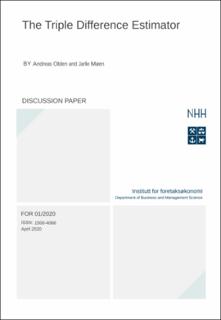The Triple Difference Estimator
| dc.contributor.author | Olden, Andreas | |
| dc.contributor.author | Møen, Jarle | |
| dc.date.accessioned | 2020-04-22T08:39:03Z | |
| dc.date.available | 2020-04-22T08:39:03Z | |
| dc.date.issued | 2020-04-22 | |
| dc.identifier.issn | 1500-4066 | |
| dc.identifier.uri | https://hdl.handle.net/11250/2652016 | |
| dc.description.abstract | Triple difference has become a widely used estimator in empirical work. A close reading of articles in top economics journals reveals that the use of the estimator to a large extent rests on intuition. The identifying assumptions are neither formally derived nor generally agreed on. We give a complete presentation of the triple difference estimator, and show that even though the estimator can be computed as the difference between two difference-in-differences estimators, it does not require two parallel trend assumptions to have a causal interpretation. The reason is that the difference between two biased difference-in-differences estimators will be unbiased as long as the bias is the same in both estimators. This requires only one parallel trend assumption to hold. | en_US |
| dc.language.iso | eng | en_US |
| dc.publisher | FOR | en_US |
| dc.relation.ispartofseries | Discussion paper;1/20 | |
| dc.subject | Triple difference | en_US |
| dc.subject | difference-in-difference-in-differences | en_US |
| dc.subject | difference-in-differences | en_US |
| dc.subject | DID | en_US |
| dc.subject | DiDiD | en_US |
| dc.subject | parallel trend assumption | en_US |
| dc.title | The Triple Difference Estimator | en_US |
| dc.type | Working paper | en_US |
| dc.source.pagenumber | 24 | en_US |
Tilhørende fil(er)
Denne innførselen finnes i følgende samling(er)
-
Discussion papers (FOR) [566]
